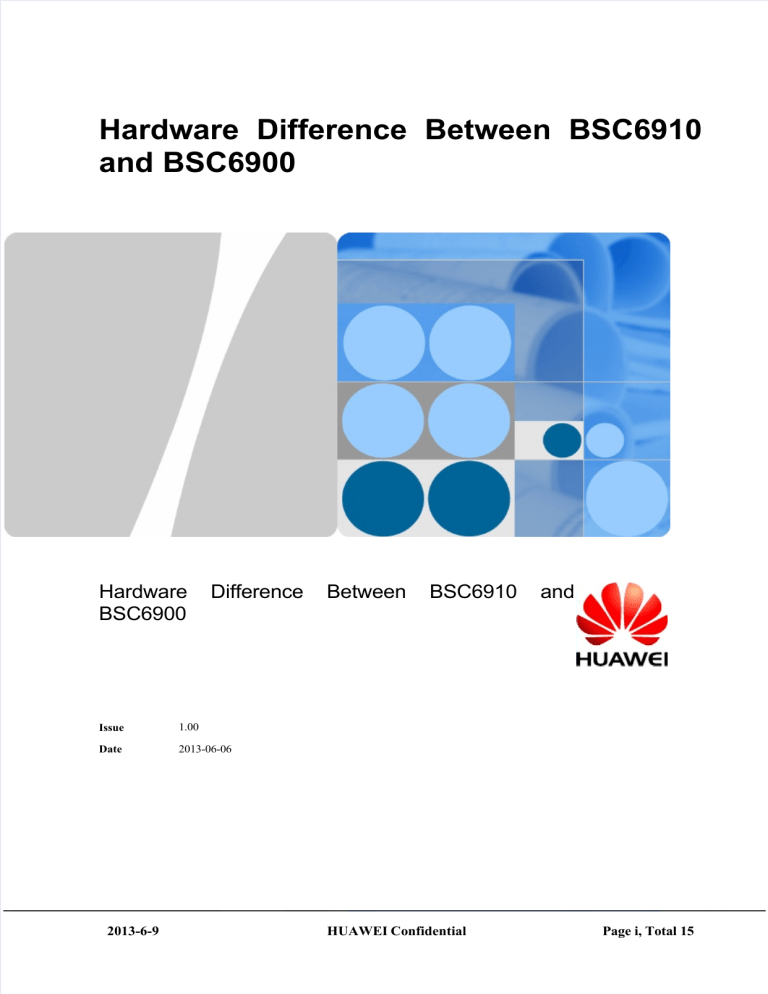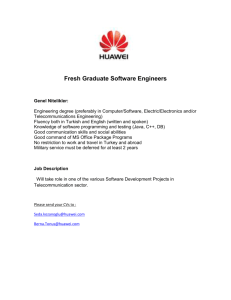
Hardware Difference Between BSC6910 and BSC6900 Hardware BSC6900 Difference Issue 1.00 Date 2013-06-06 2013-6-9 Between BSC6910 HUAWEI Confidential and Page i, Total 15 2013-6-9 HUAWEI Confidential Page ii, Total 15 About This Document Author Prepared by Shailendra Nalavade Reviewed by Date 2013-06-06 Date Reviewed by Approved by 2013-6-9 Date HUAWEI Confidential Page 3, Total 15 Contents Author 3 1. Power Connections Between PDF and BSC 5 2. DIP Switches 6 3.Subrack Board Configuration 8 错误 4.Board Level Difference 未定义书签 5.Conclusion 13 错误 References 2013-6-9 HUAWEI Confidential 未定义书签 Page 4, Total 15 3 1. Power Connection between PDF and BSC BSC6910: 2013-6-9 HUAWEI Confidential Page 5, Total 15 In each cabinet, A1 and B1 form a pair of active and standby power supply ports, as do A3 and B3. As shown in the preceding figure, to create a hot backup, connect ports A1 and A3 to one power supply group in the PDF, and ports B1 and B3 to a different power supply group. PEM 00 and PEM 01 work in active and standby mode. As shown in the preceding figure, to create a hot backup, connect OUTPUT A and OUTPUT B to a different power supply group. Circuit breakers used on the PDF must be larger than 60 A. BSC6900: A1 and B1 in each cabinet serve as a pair of active and standby power supply ports in hot backup mode, and A3 and B3 in each cabinet serve as a pair of active and standby power supply ports in hot backup mode. Therefore, as shown in the preceding figure, connect ports A1 and A3 to one power supply group in the PDF, and ports A3 and B3 to the other power supply group in the PDF. 2. DIP Switches. 2013-6-9 HUAWEI Confidential Page 6, Total 15 In BSC6910 the DIP switches are Vertical while in BSC6900 they are Horizontal. BSC6910: BSC6900: 2013-6-9 HUAWEI Confidential Page 7, Total 15 Note: The definition of the DIP switches remains the same. 3. Subrack Board Configuration The Major difference is that the OMU board position is shifted from Rear to front in BSC6910. BSC6910: 2013-6-9 HUAWEI Confidential Page 8, Total 15 Configuration of the MPS BSC6900: Configuration of the MPS in A over IP mode 4. Board Level Difference. 2013-6-9 HUAWEI Confidential Page 9, Total 15 i) The SPU/XPU and DPU processing boards of BSC6900 is replaced by single processing board EGPU. This means we have only EGPU boards in BSC6910 for both control and user plane which works in N+1 configuration. Also the EGPU boards process both CS and PS user data. For EGPU board, it automatically adjusts the NodeB or cells on the board. There is no requirement for specifying Subsystem number while configuring NodeB, 2013-6-9 HUAWEI Confidential Page 10, Total 15 ii) The electrical E1/T1 boards are no longer present in BSC6910. This means EIU,AEU,PEU boards are not present in BSC6910. 2013-6-9 HUAWEI Confidential Page 11, Total 15 iii) Only higher versions of earlier interface boards are used in BSC6910 (c and above) a and b versions interface boards are not used. So we have only AOUc,UOIc,POUc,FG2c,FG2d,GOUc,GOUd. XOUa is a new board. 2013-6-9 HUAWEI Confidential Page 12, Total 15 iv) Introduction for Evolved OMU and Evolved SAU board. 2013-6-9 HUAWEI Confidential Page 13, Total 15 v) Introduction of 10GE interface board - EXOUa 2013-6-9 HUAWEI Confidential Page 14, Total 15 5. Conclusion: This document helps to introduce about some basic hardware differences between BSC6900 and BSC6910. Besides the point mentioned in above documents there are many other differences like Resource Sharing, Management sharing, heat dissipation and others. There are also changes in the configuration part of Interfaces. Engineers are advised to study the relevant documents for more details. References: 1. Hedex 2. BSC6910 Training PPT. 2013-6-9 HUAWEI Confidential Page 15, Total 15

